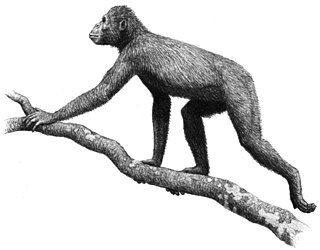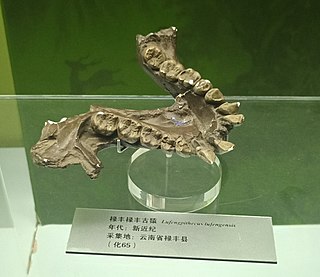
Aegyptopithecus is an early fossil catarrhine that predates the divergence between hominoids (apes) and cercopithecids. It is known from a single species, Aegyptopithecus zeuxis, which lived around 38-29.5 million years ago in the early part of the Oligocene epoch. It likely resembled modern-day New World monkeys, and was about the same size as a modern howler monkey, which is about 56 to 92 cm long. Aegyptopithecus fossils have been found in the Jebel Qatrani Formation of modern-day Egypt. Aegyptopithecus is believed to be a stem-catarrhine, a crucial link between Eocene and Miocene fossils.

Proconsul is an extinct genus of primates that existed from 21 to 17 million years ago during the Miocene epoch. Fossil remains are present in Eastern Africa including Kenya and Uganda. Four species have been classified to date: P. africanus, P. gitongai, P. major and P. meswae. The four species differ mainly in body size. Environmental reconstructions for the Early Miocene Proconsul sites are still tentative and range from forested environments to more open, arid grasslands.

The Tugen Hills are a series of hills in Baringo County, Kenya. They are located in the central-western portion of Kenya.

Proconsul africanus was an ape which lived from about 23 to 14 million years ago during the Miocene epoch. It was a fruit eater and its brain was larger than that of a monkey, although probably not as large as that of a modern ape.

Victoriapithecus macinnesi was a primate from the middle Miocene that lived approximately 15 to 17 million years ago in Northern and Eastern Africa. Through extensive field work on Maboko Island in Lake Victoria, Kenya, over 3,500 specimens have been found, making V. macinnesi one of the best-known fossil primates. It was previously thought that perhaps multiple species of Victoriapithecus were found, however the majority of fossils found indicate there is only one species, V. macinnesi. Victoriapithecus shows similarities to the extant subfamilies Colobinae and Cercopithecinae. However, Victoriapithecus predates the last common ancestor of these two groups and instead is thought to be a sister taxon.

Rusinga Island, with an elongated shape approximately 10 miles (16 km) from end to end and 3 miles (5 km) at its widest point, lies in the eastern part of Lake Victoria at the mouth of the Winam Gulf. Part of Kenya, it is linked to Mbita Point on the mainland by a causeway.
Chororapithecus is an extinct great ape from the Afar region of Ethiopia roughly 8 million years ago during the Late Miocene, comprising one species, C. abyssinicus. It is known from 9 isolated teeth discovered in a 2005–2007 survey of the Chorora Formation. The teeth are indistinguishable from those of gorillas in terms of absolute size and relative proportions, and it has been proposed to be an early member of Gorillini. However, this is controversial given the paucity of remains, and notable anatomical differences between Chororapithecus and gorilla teeth. The Kenyan ape Nakalipithecus has been proposed to be an ancestor of Chororapithecus or at least closely related. If correct, they would be the only identified fossil members of any modern non-human great ape lineage, and would push the gorilla–human last common ancestor from 8 million years ago to 10 million years ago. The teeth are adapted for processing tough plant fibres as well as hard, brittle food, and the formation is thought to represent a forested lakeside habitat.

Nakalipithecus nakayamai is an extinct species of great ape from Nakali, Kenya, from about 9.9–9.8 million years ago during the Late Miocene. It is known from a right jawbone with 3 molars and from 11 isolated teeth, and the specimen is presumed female as the teeth are similar in size to those of female gorillas and orangutans. Compared to other great apes, the canines are short, the enamel is thin, and the molars are flatter. Nakalipithecus seems to have inhabited a sclerophyllous woodland environment.

Catopithecus is an early catarrhine fossil. It is known from more than 16 specimens of a single species, Catopithecus browni, found in the Jebel Qatrani Formation of the Fayum Province, Egypt. The Jebel Qatrani Formation has been divided into two main faunal zones based on the fact that the fauna found in the lower portion of the quarry appear to be more primitive than those found in the upper section. The upper zone has been dated to older than 31 ± 1 myr based on the dating of a basalt layer that lies immediately above the formation and Nicolas Steno’s Law of Superposition. The lower zone contains the late Eocene green shale unit called Locality-41 (L-41) in which all the specimens of Catopithecus browni have been found. The relative dating of L-41 based on paleomagnetic correlations places it at 36 Myr according to Simons et al (1999), but Seiffert (2006) suggests this should be revised to 34.8-33.9 Myr.

Lufengpithecus is an extinct genus of ape in the subfamily Ponginae. It is known from thousands of dental remains and a few skulls and probably weighed about 50 kg (110 lb). It contains three species: L. lufengensis, L. hudienensis and L. keiyuanensis. Lufengpithecus lufengensis is from the Late Miocene found in China, named after the Lufeng site and dated around 6.2 Ma. It is the latest Miocene fossil ape that has been discovered in the entire world. Some researchers believe that genus Lufengpithecus could be an ancestor to African apes.
Altiatlasius is an extinct genus of mammal, which may have been the oldest known primate, dating to the Late Paleocene from Morocco. The only species, Altiatlasius koulchii, was described in 1990.
Biretia is an extinct genus of Old World monkey belonging to the extinct family Parapithecidae. Fossils are found from Late Eocene strata in Egypt.
Maboko Island is a small island lying in the Winam Gulf of Lake Victoria, in Nyanza Province of western Kenya. It is about 1.8 km long by 1 km wide. It is an important Middle Miocene paleontological site with fossiliferous deposits that were discovered in the 1930s. The age of the deposits is estimated to be 15 to 16 million years, and they are especially important for the abundance of primate fossils they contain.

Graecopithecus is an extinct genus of hominid that lived in southeast Europe during the late Miocene around 7.2 million years ago. Originally identified by a single lower jaw bone bearing a molar tooth found in Pyrgos Vasilissis, Athens, Greece, in 1944, other tooth specimens were discovered from Azmaka quarry in Bulgaria in 2012. With only little and badly preserved materials to reveal its nature, it is considered as "the most poorly known European Miocene hominoids." The creature was popularly nicknamed 'El Graeco' by scientists.
Simiolus is an extinct genus of dendropithecid primates. It was described by Mary Leakey and Richard Leakey in 1987, and the type species is S. enjiessi, which existed during the Miocene of Kenya. The species epithet is a phonetic pun on the acronym NGS. A new species, S. andrewsi, also from the middle Miocene of Kenya, was described by Terry Harrison in 2010. In November 2018, scientists reported the discovery of the smallest known ape, Simiolus minutus, which weighed approximately eight pounds, and lived about 12.5 million years ago in Kenya in East Africa.

Anapithecus is a late Miocene primate known from fossil locations in Hungary and Austria. Many Anapithecus fossils come from the site of Rudabánya, in northern Hungary, where Anapithecus lived alongside the ape Rudapithecus. The only species in the genus, Anapithecus hernyaki, is named after Gabor Hernyák, chief geologist of the Iron Ore Works of Rudabánya.
Sivaladapis is a genus of adapiform primate that lived in Asia during the middle Miocene.

The family Dendropithecidae is an extinct family of catarrhine monkeys. They date from the Early Miocene, around 20 - 12 million years ago.
Alophe metios was an early cercopithecoid monkey that lived in Kenya about 22 million years ago. It is known from jaw fragments and teeth. Although it was more closely related to modern cercopithecids than to apes, it had not evolved some features shared by crown cercopithecids and their nearest relatives, such as bilophodont molars.

Nyanzapithecus pickfordi is an extinct species of primate from the Middle Miocene of Maboko Island, Nyanza Province, Kenya. It had an average body mass of around 10 kg (22 lb).
















